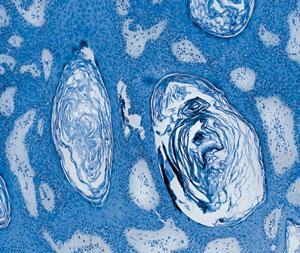The first step in treating any disease is to clarify how the disease is caused. Many questions must be answered to arrive at an understanding of what is needed to pursue new types of treatments.
- How does a person get the disease?
- Which cells are affected?
- Is the disease caused by genetic factors? If so, what genes are turned on or off in the diseased cells?
- What proteins are present or absent in diseased cells as compared with healthy cells?
- If the disease is caused by an infection, how does the infectious organism interact with the body?
In modern labs, sophisticated tools are used for shedding light on these questions. The tools are designed to uncover the molecular roots of disease and pinpoint critical differences between healthy cells and diseased cells. Researchers often use multiple approaches to create a detailed picture of the disease process. Once the picture starts to emerge, it can still take years to learn which of the changes linked to a disease are most important. Is the change the result of the disease, or is the disease the result of the change? By determining which molecular defects are really behind a disease, scientists can identify the best targets for new medicines. In some cases, the best target for the disease may already be addressed by an existing medicine, and the aim would be to develop a new drug that offers other advantages. Often, though, drug discovery aims to provide an entirely new type of therapy by pursuing a novel target.
Models for Studying Disease
The following tools help researchers gain insights into how disease develops.
Cell cultures: By growing both diseased and healthy cells in cell cultures, researchers can study differences in cellular processes and protein expression.
Cross-species studies: Genes and proteins found in humans may also be found in other species. The functions of many human genes have been revealed by studying parallel genes in other organisms.
Bioinformatics: The scientific community generates huge volumes of biological data daily. Bioinformatics helps organize that data to form a clearer picture of the activity of normal and diseased cells.
Biomarkers: These are substances, often proteins, that can be used for measuring a biological function, identifying a disease process, or determining responses to a therapy. They also can be used for diagnosis, for prognosis, and for guiding treatment.
Proteomics: Proteomics is the study of protein activity within a given cell, tissue or organism. Changes in protein activity can shed light on the disease process and the impact of medicines under study.

Selecting a target
The term target refers to the specific molecule in the body that a medicine is designed to affect. For example, antibiotics target specific proteins that are not found in humans but are critical to the survival of bacteria. Many cholesterol drugs target enzymes that the body uses to make cholesterol.
Scientists estimate there are about 8,000 therapeutic targets that might provide a basis for new medicines. Most are proteins of various types, including enzymes, growth factors, cell receptors, and cell-signaling molecules. Some targets are present in excess during disease, so the goal is to block their activity. This can be done by a medicine that binds to the target to prevent it from interacting with other molecules in the body. In other cases, the target protein is deficient or missing, and the goal is to enhance or replace it in order to restore healthy function. Biotechnology has made it possible to create therapies that are similar or identical to the complex molecules the body relies on to remain healthy.
The amazing complexity of human biology makes it a challenge to choose good targets. It can take many years of research and clinical trials to learn that a new target won’t provide the desired results. To reduce that risk, scientists try to prove the value of targets through research experiments that show the target’s role in the disease process. The goal is to show that the activity of the target is driving the course of the disease.

Developing the drug
Once a promising test drug has been identified, it must go through extensive testing before it can be studied in humans. Many drug safety studies are performed using cell lines engineered to express the genes that are often responsible for side effects. Cell line models have decreased the number of animals needed for testing and have helped accelerate the drug development process. Some animal tests are still required to ensure that the drug doesn’t interfere with the complex biological functions that are found only in higher life-forms.
 If a test drug has no serious safety issues in preclinical studies, researchers can ask for regulatory permission to do clinical trials in humans. There are three phases of clinical research, and a drug must meet success criteria at each phase before moving on to the next one.
If a test drug has no serious safety issues in preclinical studies, researchers can ask for regulatory permission to do clinical trials in humans. There are three phases of clinical research, and a drug must meet success criteria at each phase before moving on to the next one.
Phase 1: Tests in 20 to 80 healthy volunteers and, sometimes, patients. The main goals are to assess safety and tolerability and explore how the drug behaves in the body (how long it stays in the body, how much of the drug reaches its target, etc.).
Phase 2: Studies in about 100 to 300 patients. The goals are to evaluate whether the drug appears effective, to further explore its safety, and to determine the best dose.
Phase 3: Large studies involving 500 to 5,000 or more patients, depending on the disease and the study design. Very large trials are often needed to determine whether a drug can prevent bad health outcomes. The goal is to compare the effectiveness, safety, and tolerability of the test drug with another drug or a placebo.



